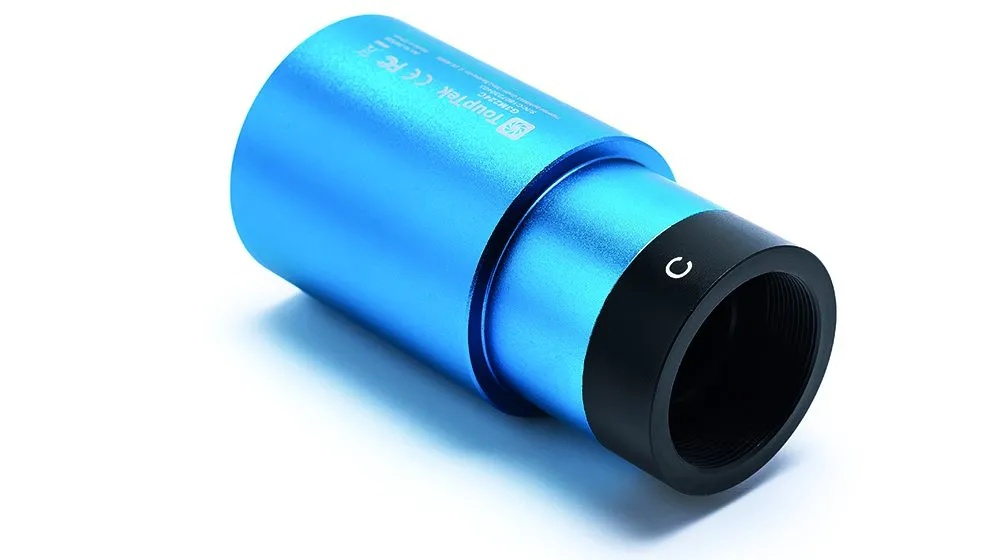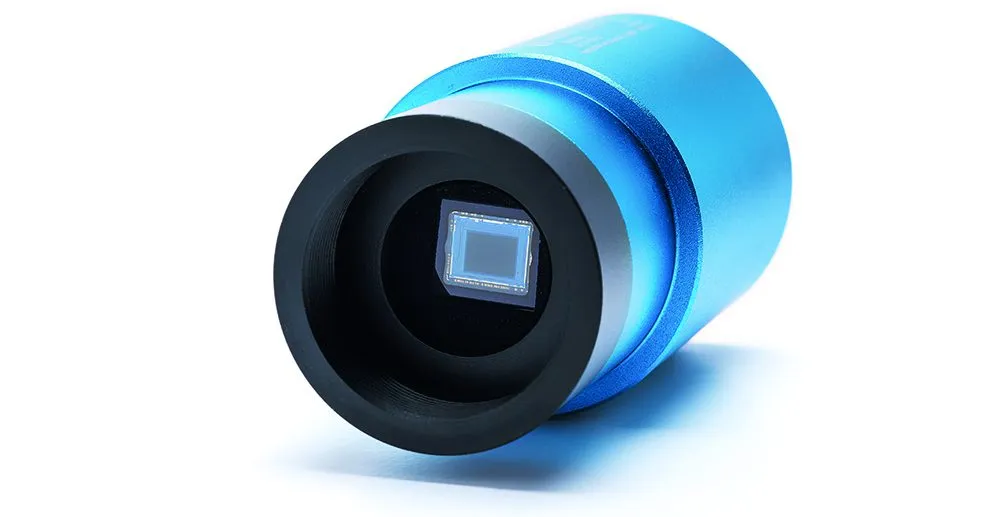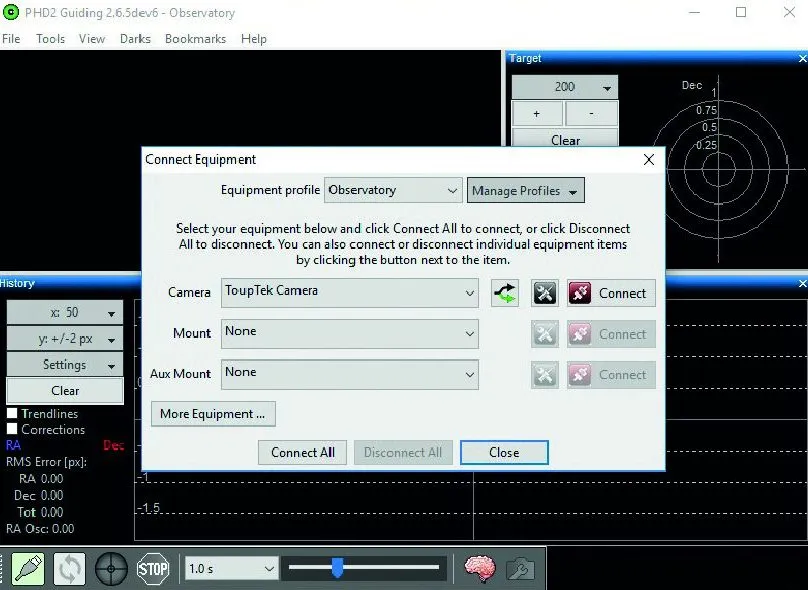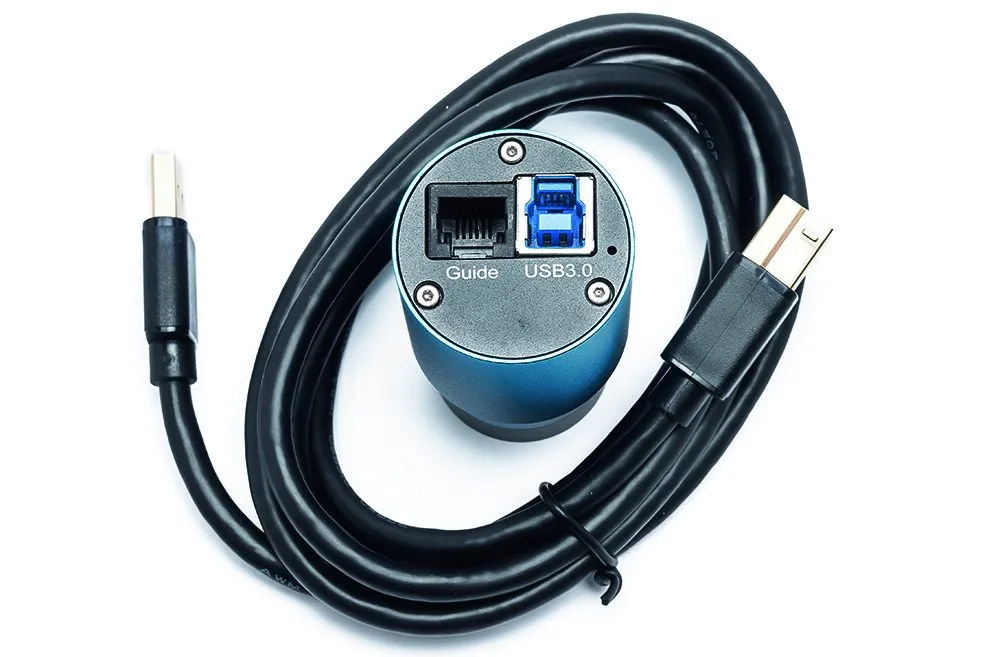Price: £269
Sensor: Sony IMX224 colour 1.2MP
Sensor size: 4.8mm x 3.6mm
Bit depth: 8-/12-bit
Max resolution: 1,280 x 960
Max frame rate at full resolution: 150 fps
ROI support: Yes
Size: 72mm x 36mm
Weight: 66g
Supplier: Omegon
Good things come in small packages, or so the saying goes.
The new G3M-224-C camera from Chinese company ToupTek certainly has a diminutive presence – it is roughly the size of a small eyepiece – so we were keen to discover what good things this keenly priced camera could produce.

Although passable as a multi-purpose camera for use on a range of both Solar System and deep-sky objects, the G3M-224-C is especially suited for planetary and lunar photography.
As such it is ideally matched with long focal-length telescopes.
To counter the issue of the exaggerated atmospheric blurring that usually accompanies high-resolution planetary imaging, a camera needs to have the ability to capture very short exposures – and lots of them – in a short time frame.
That’s something ToupTek’s little camera does very well indeed. Once a few thousand images have been captured in a video file, you can use software to pick out the sharpest frames for you and combine them.
High-speed action
At full resolution the G3M-224-C was firing images out at 150 frames per second (fps), in 8-bit mode, and if a smaller 640x480 region of interest (ROI) was chosen, that rate soared to 287fps.
Increasing the range of the camera to 12-bit mode reduced the frame rate considerably, but it was still able to throw out full-frame images at 62fps, and managed 120fps at 640x480.
With data being transferred at these speeds, having a reasonably capable USB 3.0 computer and a quick hard drive (with plenty of available space) is essential.
It is quite mesmerising to see 10,000 individual frames captured within a minute, but as the frame count goes up, so does the file size, which can greatly increase post-processing time.
We discovered a very attractive feature of the camera during an evening with clear patches between clouds.
With minimal set-up time the camera was ready to work as soon as the telescope was pointed at Mars, and we made the most of the camera speed to take image sequences between the clouds.
The camera’s almost ‘grab and go’ capability really helps work around varying weather patterns.

Our own observatory is set up with USB 2.0 connections, and although the ToupTek camera is fully compatible, there is an associated drop in frame rates.
However, we still managed 52fps with a selected ROI on Mars. Sadly, there wasn’t much planetary action to be enjoyed during our test period – the poorly placed Red Planet being the only possible candidate – but we did manage some sessions on an obliging Moon, where the simplicity and speed of capturing the video files was impressive.
Turning the G3M-224-C towards deep-sky objects produced some variable results.
By lowering the gain and increasing the exposure it was possible to capture deep-sky objects like those on the Messier list, but this is really more suited to a smaller, short-focal-length telescope.
Although image ‘noise control’ – to counter random variation of colour or brightness – is very good, you do get some glow around the edges and corners, which starts to extend into the image as exposure times increase.
Brighter objects more easily captured with shorter exposures could be reasonable targets, but really the G3M-224-C should be viewed as a Solar System camera first and foremost.
It’s worth noting that the G3M-224-C doesn’t come with a fitted blocking filter for infrared and ultraviolet light. You will almost certainly need one for most targets.
As a colour camera the ToupTek captures everything you need in each exposure, so it’s possible to adjust the colour balance of the camera within the software, which removes the slight greenish cast that may appear.
As a simple to use, fast and effective planetary camera, the ToupTek demonstrates that good things can indeed come in small packages.
A superior sensor
At the heart of this little camera is a sensor from Sony that incorporates the latest advances to achieve better image quality in dark settings.
The IMX 224 is a CMOS sensor with STARVIS technology, developed for surveillance cameras operating in low light, which therefore also makes it very attractive for astronomical cameras.
With square 3.75 micron pixels, the 4.8mm x 3.6mm chip yields images at 1.2MP in size, and with useful exposure times starting at 66 microseconds and upwards.
We found that exposures between 30 seconds and one minute produced the most pleasing results for deep-sky images.
But with the all-important need for speed on planetary targets we chose the lowest exposure time that would still yield a bright enough planetary image: a fine balance that is intuitively achieved using control sliders in the software.
The ability to ‘see’ and record faint details with very short exposures makes the Sony IMX224 an excellent sensor choice for this planetary performer.
Size and power
Measuring just over 7cm in length, and with a maximum diameter of 3.6cm, the C-mount nose of the camera fits neatly into 1.25-inch fittings.
One extension piece is included in the box, and screws on just in front of the infrared and ultraviolet anti-reflection window. As there is no active cooling system, no extra power supply is required.
Guidance software
Fully ASCOM-compatible for your preferred software, the G3M-224-C works with the latest development version of PHD2 – the popular guiding software for tracking stars.

Simply select the ‘ToupTek camera’ option from the menu and adjust the settings to optimise the camera for auto-guiding use, perhaps as a stand-in for a main guide camera.
Image control
A software CD is included in the package, with very capable ToupSky imaging software.

The program is easy to use and has a range of adjustments and features that enhance the camera for each particular target.
The live view mode makes it easy to manually focus your telescope.
Quick data transfer
Fast transfer of data between a camera and computer is a must for planetary photography, especially for targets where minimal rotation effects are desirable – such as Jupiter.
Supplied with a good quality, 1.5m USB 3.0 cable, the G3M-224-C is optimised for the speedy shuttling of images and video files from the camera to a hard drive.

Linking to a telescope
Another useful facet of the camera is its ability to link directly to a telescope mount using the ST4 guide port on the rear, via the supplied cable.
Although a computer is required to run your preferred autoguiding software, the output from the camera goes right to the mount, adjusting its position accordingly.
This review originally appeared in the February 2019 issue of BBC Sky at Night Magazine
